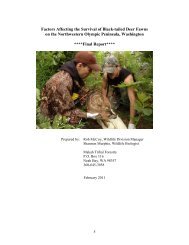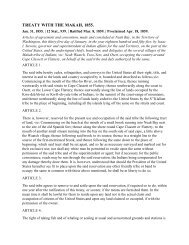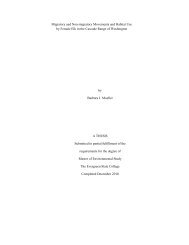Spring - NWIFC Access - Northwest Indian Fisheries Commission
Spring - NWIFC Access - Northwest Indian Fisheries Commission
Spring - NWIFC Access - Northwest Indian Fisheries Commission
- No tags were found...
Create successful ePaper yourself
Turn your PDF publications into a flip-book with our unique Google optimized e-Paper software.
Fishery Provides Extra OpportunityCool As A Sea CucumberBased on itsunusual defensemechanismalone –expelling its internalorgans toentangle or distractwould-bepredators – thehomely, bottom-dwellingsea cucumbermay test mostAmericans’idea of a tasty menu item.Nooksack fisherman Mario Narte hauls upa catch of sea cucumbers north ofBellingham in March. Photos: L.HarrisBut the leathery tube-shaped echinoderm is much loved inthe Asian diet, which is why tribal fishermen looking foryear-round harvest opportunities may increasingly pursuethe spiny creatures in Puget Sound waters. Millions of therust-colored sea cucumbers, ranging from roughly six inchesto two feet in length and beyond, are available on the PugetSound floor as they sluggishly move along while feeding onmicroscopic organisms.Diving and trawling are the common sea cucumber fishingmethods and Mario Narte, a Nooksack tribal fisherman,has fished both ways from his versatile 46-foot purse seiner,the Marysville.“It’s a way to keep fishing until shrimp season,” said Narte,whose longest sea cucumber-fishing stretch surpassed 28hours. “The more tows, the more pounds.”On his best day Narte said he brought up 2,300 pounds ofsea cucumbers, but noted 900-pound days are more common.Narte said he was getting about $1.25 per pound fromOrient Seafoods, a Vancouver, British Columbia, buyer. Thetribes were allowed 314,000 pounds in the San Juans, onlya percentage of which were available by trawl.By regulation, Narte trawls at least 120 feet deep. He mustmove to another fishing spot if bycatch of any other commerciallyharvested species exceeds 10 percent. Trawlingat only 1 knot, most species, such as crab, are able to avoidthe trawling net. Bycatch is largely limited to clamshells,seaweed, a few flatfish, and small crabs, notes Nooksackharvest manager Gary MacWilliams.MacWilliams said the fishery is closely monitored to ensurenegative impacts to other species and sea-bottom habitat remainnegligible. “We’re seeing minimal habitat degradationwith the manner restrictions currently in place,” he said.Like most tribal fishermen, Narte started out pursuingsalmon, but with declining salmon runs and fishing closureshe’s had to hustle and diversify his business. A completeshutdown of sockeye fishing in the San Juans wipedout many tribal fishermen last year, but Narte hung on partlyby fishing for shrimp, crab, sea urchins and sea cucumbers.He’s even interested in fishing sea snails as he sees moreopportunity in Asian markets.“The big heyday of sockeye salmon fishing is just aboutover,” Narte said. “You have to be creative and find othertypes of fishing if you want to survive. You have to diversify.”Trawling inroughly hourlongintervals,Narte andcrewmen EdGladstone, aNooksackmember, andBarry Westley,a Lummimember, haulup the catch.If not pretty, sea cucumbers can meanharvest opportunity for tribal fishermen.The cucumbers are separated from the rocks, weeds andbycatch and loaded onto a tray table where they are splitand drained of water. Market weight is determined afterthe creatures are split and drained.The sea cucumber is a prized food in the Asian market. Itis sold in a smoked, dried form or as a powdered dietarysupplement. It is sought for use in soups and even as anaphrodisiac. Though managed as a shellfish, the sea cucumberis an echinoderm and is closely related to the seaurchin, starfish and sand dollar. And while it may expel itsinternal organs to entangle or distract would-be predators,the organs are ultimately regenerated.Sea cucumbers may possess strange habits and a less-thanpicturesqueprofile, but with salmon seasons increasinglyclosed or restricted, the creatures can rate more beautifulthan a dime-bright sockeye.“It’s a modern reality that if a tribal fisherman wants tomake a living at fishing, he’ll have to get creative andgear up for more than salmon,” said Bob Kelly, NaturalResource Director for the Nooksack Tribe. “Fish managersare working hard to provide more opportunities andmarkets to keep fishermen working year round.”– L. Harris4









